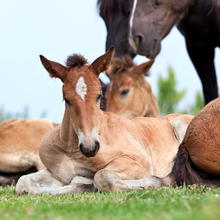Losses in early pregnancy are unusually high in the horse and it is believed that female embryos are especially prone to spontaneous abortion. Male embryos are known to be better able to survive under high glucose concentrations, so well-nourished mares often give birth to male foals.

Research - Ratio of male to female horses
It is believed female embryos in horses are prone to spontaneous abortion, but research provides information on how the survival of female embryos may be enhanced under conditions that would tend to favor the birth of males.
It is well known that many mammals are able to adjust the ratio of male and female young depending on the surrounding conditions at the time of conception but how precisely this is accomplished remains a matter for debate.
A recent study in the group of Christine Aurich at the University of Veterinary Medicine, Vienna, has provided important information on how the survival of female embryos may be enhanced under conditions that would otherwise tend to favor the birth of males.
Because of the process involved in the formation of sperm cells, there should be an equal chance that a mammalian egg will be fertilized by "male" sperm, carrying a Y chromosome, as by a "female" sperm, carrying an X chromosome. The symmetry of the system ensures that roughly the same number of males and females are born, which is clearly helpful for the species' long-term survival.
Surprisingly, though, many mammals do not produce equal numbers of male and female offspring.
The discrepancy could theoretically be explained by differential fertilization efficiencies of male and female sperm (Y chromosomes are smaller than X chromosomes so perhaps male sperm can swim faster?) or by different rates of survival of male and female foetuses in the uterus.
Indeed, it does seem as though male embryos are better able to survive under conditions of high energy intake. But how does this work?
Jana Beckelmann in Christine Aurich's laboratory at the University of Veterinary Medicine, Vienna has presented evidence that a particular protein, insulin-like growth factor-1 or IGF1, might somehow be involved.
From an examination of about 30 embryos, Beckelmann noticed that during early pregnancy (between eight and twelve days after fertilization) the level of messenger RNA encoding IGF1 was approximately twice as high in female embryos as in male embryos.
The difference could relate to the fact that female embryos have two X chromosomes, which might produce more of a factor required for the expression of the IGF1 gene (which is not encoded on the X chromosome) than the single X chromosome in males is able to generate. Beckelmann was also able to confirm that the IGF1 protein was present in the embryos, confirming that the messenger RNA is actually translated to protein.
IGF1 is known to have important functions in growth and to inhibit apoptosis, or programmed cell death. As IGF1 treatment of cattle embryos produced in vivo improves their survival, it is likely that the factor has positive effects on the development of the early embryo in the horse. So why should female embryos contain more of the factor than males?
As Beckelmann says, "We think the higher IGF1 concentrations in female embryos might represent a mechanism to ensure the survival of the embryos under conditions that would otherwise strongly favor males." If this is so, the ratio of the sexes in horses is the result of a subtle interplay between environmental and internal factors, including insulin-like growth factor-1.
